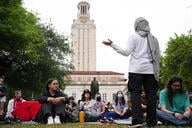You have /5 articles left.
Sign up for a free account or log in.

The latest free speech survey looks at the public’s perception of how the issue is manifesting on college campuses.
Photo illustration by Justin Morrison/Inside Higher Ed | Rawpixel
A new survey on the public’s views of free expression on college campuses emphasizes the complexity of the issue, experts say.
Respondents gave seemingly contradictory answers to survey questions regarding how and when speech should be restricted on campus. For example, while 61 percent said college officials should not be able to fire a tenured professor for using speech that some people find offensive, more than 80 percent said professors should not be allowed to express racist views. About the same share of respondents also said that professors should not be allowed to express sexism, while a slightly smaller majority—about seven in 10 people—said professors should not promote political or religious beliefs.
Sean Stevens, director of polling and analytics at the Foundation for Individual Rights and Expression, a free expression advocacy organization, observed that while respondents seemed to dislike the idea of administrators tamping down faculty speech, “they still kind of want it restricted somehow, and I’m not sure who they would want doing that.”
Survey respondents were also divided in choosing which is the bigger problem on campus: people spreading harmful or misleading speech (54 percent) or people being stopped from saying what they want (42 percent).
Yet asked about the key purpose of higher education, the vast majority of respondents—90 percent—said they see campuses as places where disparate ideas and values can and should be discussed. At the same time, 55 percent said students should not be allowed to invite speakers to campus who have said something offensive.
The survey, released Monday by the University of Chicago Forum for Free Inquiry and Expression and the Associated Press–NORC Center for Public Affairs Research, utilized a sample of 1,095 U.S. adults intended to be representative of the nation’s households. Its timing coincides with this week’s launch of the university’s Forum for Free Inquiry and Expression, a center focused on the promotion of free and open discourse.
Heidi Tseu, the assistant vice president of national engagement for the American Council on Education, said the survey underscores the nuances of the campus free speech debate, a topic that often gets boiled down to campus speaker shoutdowns or professors being fired over controversial tweets.
That complexity points to how college and university leaders should be thinking about addressing the topic on their campuses, she added.
“I think people understand this isn’t about one-size-fits-all solutions,” she said. “This requires our campus leaders to continue the work they’re doing to preserve the balance on their campus.”
Why Ask the Public?
The survey also asked whom the public believes is most and least able to express themselves on campus. Respondents were more likely to report that institutions do a good job of providing “a respectful and inclusive environment” for liberals (46 percent) than for conservatives (27 percent)—results that are consistent with other free speech surveys.
In recent years, numerous studies have evaluated what students and other college constituents think about free expression rights on their campuses. But few have explored how the public perceives such issues.
Tseu said it’s important to understand how the general populace feels about free expression in higher education, in part because those perceptions can impact the way legislators view—and in some cases, attempt to intervene in—the so-called campus speech crisis.
Michelle Deutchman, the executive director of the University of California National Center for Free Speech and Civic Engagement, said that although free speech is often seen as a problem that manifests in a unique way on college campuses, polarization also disrupts spaces outside of higher education. Understanding the public’s perception of campus free speech can therefore lead to broader insights.
“In higher ed, we can sort of forget we’re not just talking to ourselves,” she said. “A lot of the issues that are facing higher education, and therefore democracy, are those that impact people who are not in the academy, who don’t have college degrees, who don’t have access for whatever reason.”
Deutchman noted that the vague phrasing of some survey questions may have impacted the responses. Most notably, she argued that respondents might have provided different answers to questions about which actions by students and professors should be restricted if the wording had specified context.
“The devil’s in the details,” she said, referring to a question about whether students should be able to promote their religious views; 54 percent of people said they should. “Where are we talking about? In the quad? In someone’s dorm room? In the classroom? Is the class on religious studies or is the class on math?”
The questions add yet another dimension to the debate between free and restricted speech—a debate that, as this survey shows, remains murky and complex.




